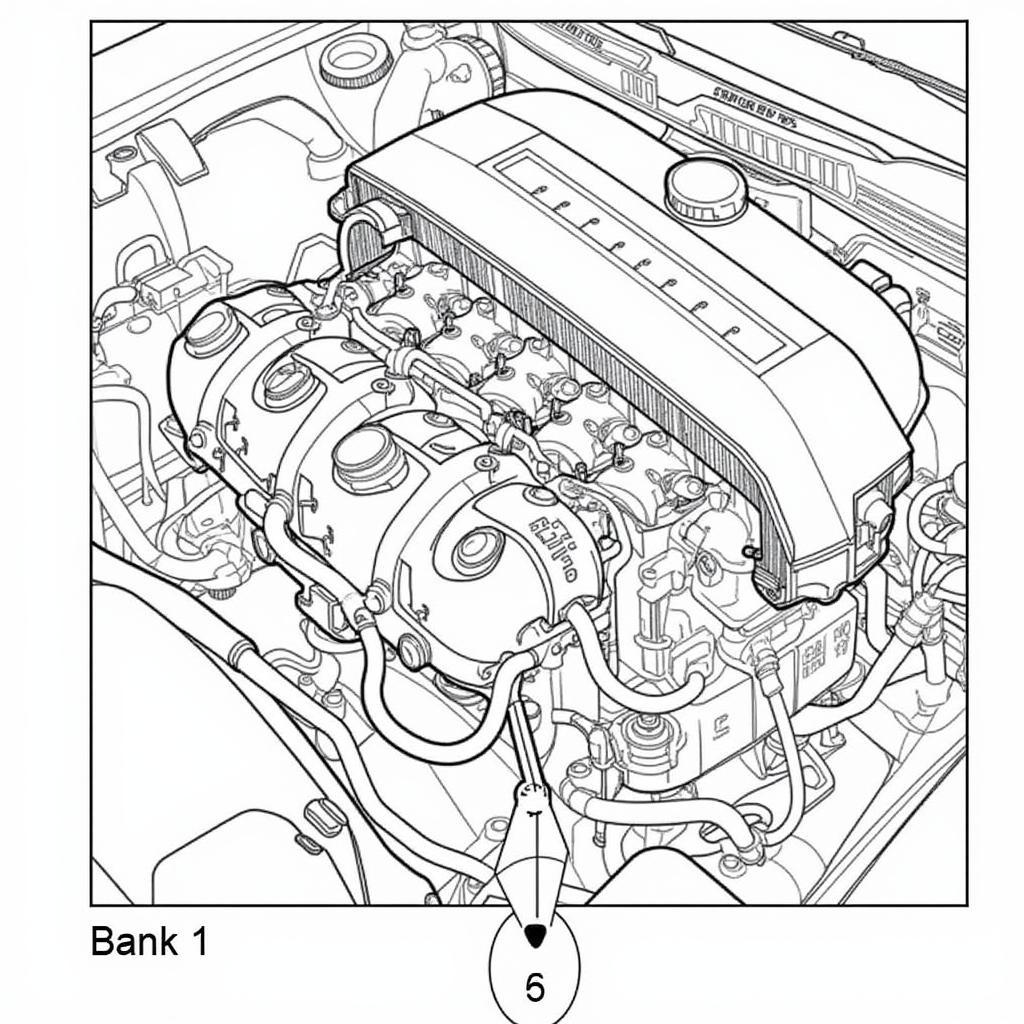The Check Engine Light illuminating on your Chevy dashboard can be a real mood killer. If a quick scan reveals the dreaded P0131 code, don’t fret! This simply means there’s a problem with your oxygen sensor, specifically the one before the catalytic converter on Bank 1 (where cylinder #1 resides). This article delves into the intricacies of this code, its potential causes, symptoms, and solutions to help you conquer this common Chevy ailment.
What Does Code P0131 Mean?
The P0131 code specifically indicates that your car’s Engine Control Module (ECM) has detected low voltage from the oxygen sensor’s signal circuit. This sensor, often called an O2 sensor, plays a vital role in monitoring the exhaust gases leaving the engine and relaying this information to the ECM. This data is crucial for the ECM to adjust the air-fuel mixture for optimal engine performance and fuel efficiency.
Common Causes of a P0131 Code
A variety of issues can trigger a P0131 code in your Chevy. Here are some of the most prevalent culprits:
-
Faulty Oxygen Sensor: Over time, oxygen sensors can wear out or become contaminated with fuel additives and engine oil, leading to inaccurate readings and triggering the code.
-
Wiring Problems: Damaged, corroded, or loose wiring connections between the oxygen sensor and the ECM can disrupt the voltage signal, causing the P0131 code.
-
Exhaust Leaks: Leaks in the exhaust manifold, exhaust pipes, or even a loose oxygen sensor can introduce excess oxygen into the exhaust stream, confusing the sensor and leading to a low voltage reading.
-
Vacuum Leaks: Similar to exhaust leaks, leaks in the vacuum system can upset the air-fuel mixture, impacting the oxygen sensor’s readings and triggering the code.
-
Faulty Fuel Pressure Regulator: A malfunctioning fuel pressure regulator can cause an overly rich fuel mixture, leading to incorrect readings by the oxygen sensor and triggering the P0131.
Symptoms of a P0131 Code
Besides the obvious illuminated Check Engine Light, a P0131 code can manifest through several noticeable symptoms:
-
Decreased Fuel Economy: As the ECM struggles to maintain an optimal air-fuel mixture, you might experience a drop in your Chevy’s fuel efficiency.
-
Engine Performance Issues: Hesitation, rough idling, or a lack of power during acceleration can all signal a problem with the oxygen sensor circuit.
-
Failed Emissions Test: A malfunctioning oxygen sensor can disrupt your vehicle’s emissions control system, potentially leading to a failed emissions test.
Diagnosing the P0131 Code
Accurately diagnosing the root cause of a P0131 code often requires a multi-step approach:
-
Read the Code: Begin by connecting an OBD2 scanner to your Chevy’s diagnostic port and reading the stored trouble codes.
-
Inspect the Oxygen Sensor: Visually examine the oxygen sensor and its wiring harness for any signs of damage, corrosion, or loose connections.
-
Check for Exhaust Leaks: Start your engine and listen for any hissing sounds coming from the exhaust system, indicating potential leaks.
-
Test the Sensor Voltage: Use a multimeter to check the voltage signal from the oxygen sensor. A consistently low voltage reading often suggests a faulty sensor.
Repairing a P0131 Code
Addressing a P0131 code generally involves one or more of the following solutions:
-
Oxygen Sensor Replacement: Replacing a faulty oxygen sensor is often the most effective solution. It’s crucial to use the correct OEM or equivalent sensor for your specific Chevy model.
-
Wiring Repair: If you discover damaged or corroded wiring, repairing or replacing the affected sections can restore proper communication between the sensor and the ECM.
-
Exhaust Leak Repair: Repairing any exhaust leaks is essential to ensure accurate oxygen sensor readings and proper engine performance.
-
Addressing Vacuum Leaks: Identifying and repairing vacuum leaks can help restore the correct air-fuel mixture and prevent future oxygen sensor issues.
-
Fuel Pressure Regulator Replacement: If a faulty fuel pressure regulator is the culprit, replacing it can rectify the rich fuel mixture causing the P0131 code.
Expert Insights
“Ignoring a P0131 code can lead to catalytic converter damage, which can be a costly repair,” advises Mike Thompson, ASE Certified Master Technician. “Addressing the issue promptly can save you money and headaches in the long run.”
Conclusion
A Chevy OBD2 code P0131, indicating a low voltage issue with your oxygen sensor, might seem daunting, but armed with the knowledge in this article, you can confidently diagnose and resolve the problem. Don’t let this common code put a damper on your driving experience. Remember, timely action can restore your Chevy’s performance, fuel efficiency, and keep your Check Engine Light at bay.
FAQs
-
Can I still drive my Chevy with a P0131 code?
- While you might be able to drive for a short period, ignoring the code can lead to further damage and costlier repairs. It’s best to address the issue promptly.
-
How long does it take to replace an oxygen sensor?
- Replacing an oxygen sensor is a relatively straightforward repair for a mechanic and typically takes less than an hour.
-
How much does it cost to fix a P0131 code?
- The cost of repair varies depending on the root cause. A new oxygen sensor can range from $50 to $200, while labor costs might add another $100 to $200.
-
Can I replace the oxygen sensor myself?
- If you’re mechanically inclined, you might be able to replace the sensor yourself. However, if you’re unsure, it’s always best to consult a qualified mechanic.
-
How can I prevent future P0131 codes?
- Regular vehicle maintenance, including timely spark plug replacements and air filter changes, can help prevent oxygen sensor issues.
Need More Help with Your Chevy’s OBD2 Codes?
For expert guidance and assistance with your Chevy’s OBD2 codes, feel free to reach out to our team. We offer 24/7 support via WhatsApp at +1(641)206-8880 or email us at [email protected]. Our dedicated team is ready to help you get back on the road quickly and safely!


